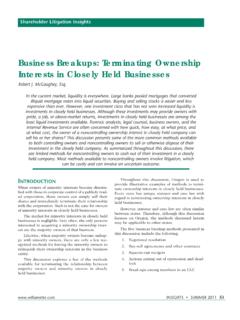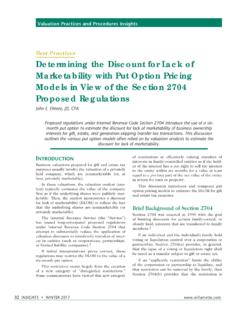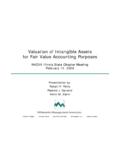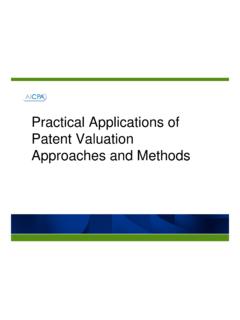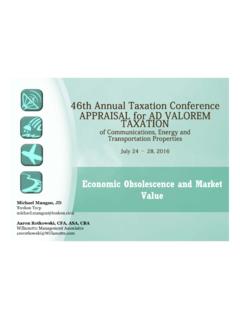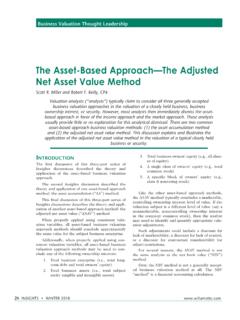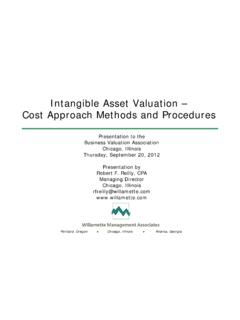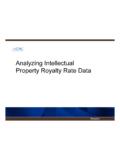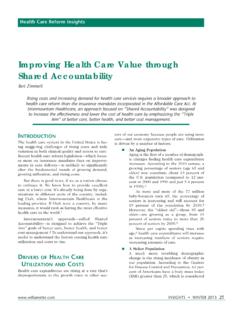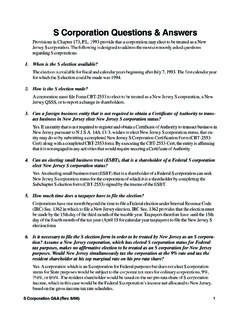Transcription of Valuation Issues in the C Corporation to S …
1 INSIGHTS SPRING 2012 17 Valuation Issues in the C Corporation to S Corporation ConversionDavid M. ChiangIncome Tax Valuation InsightsThis discussion addresses the Valuation Issues related to the federal income tax conversion from C Corporation status to S Corporation status. These Valuation Issues include (1) the eligibility requirements for a C Corporation taxpayer to convert to S Corporation status, (2) the application of a Valuation discount for lack of marketability, (3) the Valuation consideration of the built-in gains tax liability, and (4) the appropriate standard of value to apply in the C Corporation to S Corporation conversion onThe popularity of a company structuring itself as a tax pass-through entity has increased materially during the last 25 on the latest data available from the Internal Revenue Service (the Service )
2 , tax pass-through entities (excluding partnerships and sole proprietorships) have increased from 24 percent of all corporations in 1986 to 69 percent of all corporations in increase in the number of companies imple-menting a tax pass-through structure can be mainly attributed to the elimination of one layer of federal income taxation ( , the avoidance of corporate level taxation) in such a tax structure. As a result, many companies that were previously taxed as C corporations have elected to convert to S corpora-tion tax regular C Corporation is taxed at the corpo-rate level for federal income tax purposes.
3 In addi-tion, the C Corporation shareholders are also taxed on any capital gains realized by the shareholder and on any dividend income distributed from the C contrast, the shareholders of an S corpora-tion only pay one level of federal income tax. This is because the S Corporation will pass-through all of its income (and its losses) to the S Corporation corPoraTI on conversion IssuesThe S Corporation itself is not subject to federal income tax. The S Corporation income (or losses) that flows to the shareholder is reported on the shareholder s personal income tax return.
4 This income is taxed at the shareholder s individual income tax are several Issues that should be consid-ered related to the C Corporation conversion to S Corporation federal income tax status. The following discussion summarizes the Valuation Issues regard-ing an S Corporation corPoraTI on elIgIbIlIT y requIremenTsA C Corporation must meet several statutory require-ments in order to convert to S Corporation to Internal Revenue Code Section 1361 ( Section 1361 ) and the corresponding 18 INSIGHTS SPRING 2012 , a company elect-ing S Corporation status must meet the following eligibility requirements:1.
5 The company must be a domestic The company must have shareholders that consist only of individuals, cer-tain trusts, and estates. Nonqualified sharehold-ers include partnerships, corporations, and foreign individuals or The company must have no more than 100 The company must have only one class of stock, although the stock can be differenti-ated with voting and nonvoting characteris-tics. Furthermore, distributions and liqui-dations to shareholders must be conducted on a pro rata basis. 5. The company must not be an ineligible Corporation ; ineligible corporations include certain financial institutions, insurance companies, and domestic international sales to these eligibility requirement, many com-panies simply do not qualify to elect S Corporation federal income , in order to maintain the company s S cor-poration election, the pool of potential shareholders and potential buyers is often reduced.
6 This reduc-tion is due to any tax-status-related shareholder restrictions stated in the Corporation s shareholder example, the sale of the S Corporation stock to a nonqualified shareholder of an S corpo-ration would immediately revoke the S corpora-tion status, resulting in the loss of the income tax For lack oF markeTabIlIT yThe consensus of Valuation analysts, judicial deci-sions, and empirical studies is that an investment is worth more if it is readily marketable. Conversely, an identical investment is worth less if it is not read-ily difference in price that an investor will pay for a liquid asset compared to an otherwise identical illiquid asset is often substantial.
7 This price differ-ence is commonly referred to as the discount for lack of marketability (DLOM).As previously mentioned, S Corporation share-holders are limited by:1. the specified types of shareholders that qualify for S Corporation ownership and 2. the number of shareholders that are permit-ted in an S a result, the potential buyers of S Corporation shares are limited as to (1) the specified types of shareholders and (2) the number of shareholders. This statutory limitation allows the taxpayer cor-poration to maintain its S Corporation income tax to the restriction of types and number of buyers, a discount for lack of marketability is often appropriate in the fair market value Valuation of the S Corporation on adjusTmenT For buIlT-In caPITal gaInsFor a period of 10 years after the C Corporation to S Corporation conversion date (also called the rec-ognition period )
8 , the converted S Corporation is subject to built-in gains built-in gains tax relates to the sale or trans-fer of either the entire company or certain is a limitation to the recognition of the built-in gain. This limitation is based on the net unrealized built-in gain (NUBIG) of the company or the assets as of the conversion CalculationAccording to Regulations Section , the S Corporation NUBIG is calculated as follows:the amount that would be realized if the taxpayer Corporation had remained a C Corporation and had sold all its assets at fair market value to an unrelated party that assumed all its liabilitiesdecreased by For a period of 10 years after the C Corporation to S Corporation conversion date.
9 The converted S Corporation is subject to built-in gains tax. INSIGHTS SPRING 2012 19any liability of the Corporation that would be included in the amount realized on the sale, but only if the Corporation would be allowed a deduction for the payment of the liabilitydecreased bythe aggregate adjusted bases of the corpora-tion s assets at the time of the saleincreased or decreased bythe Corporation s Section 481 adjustments that would be taken into account on the saleincreased byany recognized built-in loss that would not be allowed as a deduction under Sections 382, 383.
10 Or 384 on the Tax AmountThe federal income tax amount to be paid is determined by multiplying:1. the lesser of the net recognized built-in gain or the net unrealized built-in gain by2. the maximum federal corporate income tax at the time of the com-pany (or asset) a C Corporation converting to an S corpora-tion, it is important for the taxpayer to calculate the NUBIG. Otherwise, the Corporation runs the risk of subjecting the entire gain from the sale to corporate level tax during the entire recognition addition, tax advisers recommend that the conversion Corporation should allocate NUBIG among all of the taxpayer Corporation assets.
